story by Jamie Rector and Kayte Deioma, photos by Jamie Rector
A downpour somehow seems an appropriate accompaniment to the glorious and gritty soul of Motown, which produced such hits as “I Wish it Would Rain” and “Tears of a Clown.”
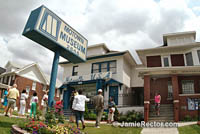 The Motown Historical Museum is one of the more popular tourist attractions in Detroit, though you wouldn’t necessarily know it from its location. About 15 minutes from downtown, past an old hospital, in a semi-residential, semi worn-down area, stand the modest buildings of Motown and Hitsville USA. The street in front is lined with tour buses. The two clean and restored houses that comprise the museum were the studio and office area of the Motown Record Corporation from 1959 to 1972 when it moved to Los Angeles. Signs point the way to the visitor entrance.
The Motown Historical Museum is one of the more popular tourist attractions in Detroit, though you wouldn’t necessarily know it from its location. About 15 minutes from downtown, past an old hospital, in a semi-residential, semi worn-down area, stand the modest buildings of Motown and Hitsville USA. The street in front is lined with tour buses. The two clean and restored houses that comprise the museum were the studio and office area of the Motown Record Corporation from 1959 to 1972 when it moved to Los Angeles. Signs point the way to the visitor entrance.
Making Musical History
Berry Gordy, Jr. started his fledgling record label with an $800 loan from his family. When he bought the first house on West Grand Boulevard in Detroit in 1959 and dubbed it Hitsville USA, he planned to apply the same philosophy to making hit records that the Ford Company applied to producing cars. Starting with Smoky Robinson and the Miracles, Gordy staffed his hit factory with a talented assembly line of song writers, arrangers, house musicians and front line talent to create the unique sound that became known as Motown. The company grew to occupy eight houses on West Grand before moving the headquarters to downtown Detroit and later, Los Angeles.
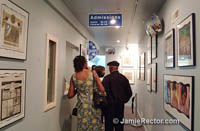 Just past the friendly guard, a long hallway filled with historic photographs welcomes visitors to the home of funk. All the main players are there: Smokey Robinson, Stevie Wonder, The Jackson Five, Diana Ross and many other familiar faces.
Just past the friendly guard, a long hallway filled with historic photographs welcomes visitors to the home of funk. All the main players are there: Smokey Robinson, Stevie Wonder, The Jackson Five, Diana Ross and many other familiar faces.
Tours run continuously, beginning as soon as they have enough people to start. After a brief introduction, and strict instructions to keep the cameras put away, the tour guide walks the group through a series of rooms with more classic photos of legends in their hey day, as well as original record covers, memorabilia, and gold records. The exhibit also includes stage costumes worn by Motown artists including Michael Jackson’s original hat and white sequined glove.
The Michael Jackson memorabilia was once stolen right out the museum. There was no case around it at the time. It didn’t take much clever sleuthing to find the thief. The day it was stolen, there was only one guest – and he signed the guestbook, complete with address. They tracked him down and got the items back. They were so happy to have the pieces back they didn’t even bother to press charges.
The living room, dining room and kitchen of what used to be Berry Gordy’s apartment, is restored to its 1959-60 appearance. Some of the original furniture remains, so it can be seen just the way it was. It is roped off, so you can look but not touch.
After this glimpse into daily life in the Motown house, the tour moves to the backbone of the Motown business – the office where it all began and where artists were signed. There are original notes and paperwork in the office giving it the feel that you have stepped back in time.
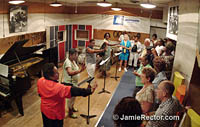 Adjacent to the office is the control room and the recording studio. The piano and drum set stand ready for the house band, the Funk Brothers, to walk in and start playing. Having all the singing groups record with the same backup band created that consistency of sound that is so Motown. Although largely unknown as individual musicians, the story of the Funk Brothers’ contribution to the Motown sound has recently been told in the documentary, Standing in the Shadows of Motown. In addition to Funk Brother Earl Van Dyke, the piano was also played by Marvin Gaye and Stevie Wonder, who both broke the Motown assembly line mold by being songwriters, musicians and singers.
Adjacent to the office is the control room and the recording studio. The piano and drum set stand ready for the house band, the Funk Brothers, to walk in and start playing. Having all the singing groups record with the same backup band created that consistency of sound that is so Motown. Although largely unknown as individual musicians, the story of the Funk Brothers’ contribution to the Motown sound has recently been told in the documentary, Standing in the Shadows of Motown. In addition to Funk Brother Earl Van Dyke, the piano was also played by Marvin Gaye and Stevie Wonder, who both broke the Motown assembly line mold by being songwriters, musicians and singers.
You can’t sit at the famous piano, but you might get a chance to stand where icons like Smokey Robinson, the Temptations, the Four Tops and Diana Ross and the Supremes stood to record their chart-smashing hits – an experience not to be missed.
Motown Historical Museum
2648 W. Grand Boulevard
Detroit, Michigan 48208
(313) 875-2264
www.motownmuseum.com

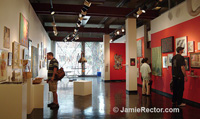 Detroit isn’t known as an arts Mecca, but it has plenty of art around to appreciate, from the classics to the avant-garde. From the centuries of fine art on display at the Detroit Institute of Arts to the diversity of vendors at the Artist Market – established in 1932 and still going strong – to newer clusters of galleries springing up in nearby Wyandotte, Detroit has a long history of art appreciation and production.
Detroit isn’t known as an arts Mecca, but it has plenty of art around to appreciate, from the classics to the avant-garde. From the centuries of fine art on display at the Detroit Institute of Arts to the diversity of vendors at the Artist Market – established in 1932 and still going strong – to newer clusters of galleries springing up in nearby Wyandotte, Detroit has a long history of art appreciation and production.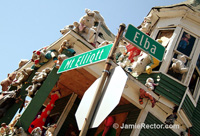 covers one block in a low-income residential neighborhood. Some people love it and some hate it, but either way, it’s worth a look to see what everyone is talking about. The controversy has contributed to making it the third most visited site in Detroit.
covers one block in a low-income residential neighborhood. Some people love it and some hate it, but either way, it’s worth a look to see what everyone is talking about. The controversy has contributed to making it the third most visited site in Detroit.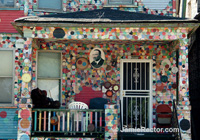 Polka Dots are splashed all over the run down neighborhood. The dots symbolize the various races of the world coming together. Houses are decorated in themes. The various exhibits represent the human condition with seemingly random pieces of junk; Stuffed animals, furniture, shoes, vacuum cleaners
you name it, it’s in there somewhere. If it’s not there, I’m sure it could easily be incorporated. Make sure you look for the series of faces around the neighborhood representing the diversity of the faces of God. The faces are painted on car hoods and have been exhibited in other locations as The Painted Hoods of Tyree Guyton.
Polka Dots are splashed all over the run down neighborhood. The dots symbolize the various races of the world coming together. Houses are decorated in themes. The various exhibits represent the human condition with seemingly random pieces of junk; Stuffed animals, furniture, shoes, vacuum cleaners
you name it, it’s in there somewhere. If it’s not there, I’m sure it could easily be incorporated. Make sure you look for the series of faces around the neighborhood representing the diversity of the faces of God. The faces are painted on car hoods and have been exhibited in other locations as The Painted Hoods of Tyree Guyton.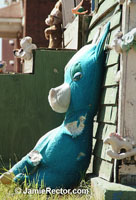 The Heidelberg Project provides after-school art education to neighborhood children and has driven most of the illegal activity out of the neighborhood by making it impossible for them to do business under the scrutiny of hundreds of visitors a day. The City has demolished several of Guyton’s creations over the years, which was easy for them to do since the houses were abandoned and derelict City-owned properties before Guyton started working on them. Simultaneously, City art institutions and the international arts community have bestowed upon Guyton a variety of prestigious arts awards and the artist has appeared on Good Morning America and Oprah to talk about the project.
The Heidelberg Project provides after-school art education to neighborhood children and has driven most of the illegal activity out of the neighborhood by making it impossible for them to do business under the scrutiny of hundreds of visitors a day. The City has demolished several of Guyton’s creations over the years, which was easy for them to do since the houses were abandoned and derelict City-owned properties before Guyton started working on them. Simultaneously, City art institutions and the international arts community have bestowed upon Guyton a variety of prestigious arts awards and the artist has appeared on Good Morning America and Oprah to talk about the project. If you’re in downtown Detroit on business and find yourself with a little free time on a rainy or snowy day, your connection to anywhere you might want to be in the central business district is the Detroit People Mover. This light rail system that makes a loop through 13 stations is built high above traffic and provides excellent views of the city, its landmarks and the Detroit River. Since eight of the People Mover stations are inside buildings, you have access to over nine million square feet of retail shopping, entertainment venues, hotels, offices, civic center services and residential space without ever going outside.
If you’re in downtown Detroit on business and find yourself with a little free time on a rainy or snowy day, your connection to anywhere you might want to be in the central business district is the Detroit People Mover. This light rail system that makes a loop through 13 stations is built high above traffic and provides excellent views of the city, its landmarks and the Detroit River. Since eight of the People Mover stations are inside buildings, you have access to over nine million square feet of retail shopping, entertainment venues, hotels, offices, civic center services and residential space without ever going outside. The People Mover stops at the Renaissance Center, Detroit’s most recognizable architectural landmark. Six high rise office towers surround the 73 story cylindrical Marriot Hotel at its center.The Ren Cen, as its known locally, has gone through its ups and downs since Henry Ford II and a group of local developers opened it in 1977. GM bought the complex in 2001 and did a complete makeover that got its final touches in 2005. The Ren Cen offers a one-hour tour four times a day, six days per week. The tour starts at the General Motors Wintergarden, a five-story glass atrium with two levels of local and international chain boutiques and restaurants. Other highlights
The People Mover stops at the Renaissance Center, Detroit’s most recognizable architectural landmark. Six high rise office towers surround the 73 story cylindrical Marriot Hotel at its center.The Ren Cen, as its known locally, has gone through its ups and downs since Henry Ford II and a group of local developers opened it in 1977. GM bought the complex in 2001 and did a complete makeover that got its final touches in 2005. The Ren Cen offers a one-hour tour four times a day, six days per week. The tour starts at the General Motors Wintergarden, a five-story glass atrium with two levels of local and international chain boutiques and restaurants. Other highlights 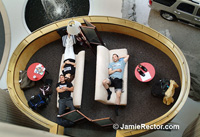 include GM World, a showcase for past, present and future GM cars; a tour of the movie theatre and an elevator ride up to the 72 nd floor to admire the view – 30 miles on a clear day.
include GM World, a showcase for past, present and future GM cars; a tour of the movie theatre and an elevator ride up to the 72 nd floor to admire the view – 30 miles on a clear day.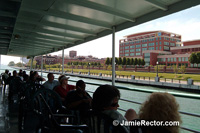 Also at the Renaissance Center stop, just off the Promenade on the Detroit River is the
Also at the Renaissance Center stop, just off the Promenade on the Detroit River is the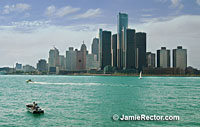 keeping company with Sailboats and barges making their own way along the mile-wide waterway. The tour passes the Mayor’s residence, the Manoogian Mansion, nestled along the shore. The vessel continues to meander under the MacArthur Bridge and around Belle Isle and back down on the Canadian side. Friendly Canadians wave to the ship as it floats past downtown Windsor and waterfront residences and eventually under the mighty Ambassador Bridge before it heads back along Hart Plaza and Joe Lewis Arena into downtown Detroit.
keeping company with Sailboats and barges making their own way along the mile-wide waterway. The tour passes the Mayor’s residence, the Manoogian Mansion, nestled along the shore. The vessel continues to meander under the MacArthur Bridge and around Belle Isle and back down on the Canadian side. Friendly Canadians wave to the ship as it floats past downtown Windsor and waterfront residences and eventually under the mighty Ambassador Bridge before it heads back along Hart Plaza and Joe Lewis Arena into downtown Detroit.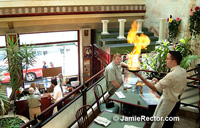 Greektown is the People Mover stop you want for great food and a cultural experience. The street is strung with flags and lined with restaurants, bakeries and shops all offering the look, feel and taste of walking through a street in Greece. The price range varies from a nice basic restaurant to an elegant eating experience. Make sure to check out the Saganaki at the multi-level New Parthenon Restaurant. The flaming cheese is always fun to watch and this establishment is reputed to be the inventor of this Detroit-Greek delicacy. “Opa!” Once your tummy is full from any of the more than 20 restaurants, bakeries or shops, you can empty your pockets at the Greektown Casino on the corner with free validated parking in their parking structure.
Greektown is the People Mover stop you want for great food and a cultural experience. The street is strung with flags and lined with restaurants, bakeries and shops all offering the look, feel and taste of walking through a street in Greece. The price range varies from a nice basic restaurant to an elegant eating experience. Make sure to check out the Saganaki at the multi-level New Parthenon Restaurant. The flaming cheese is always fun to watch and this establishment is reputed to be the inventor of this Detroit-Greek delicacy. “Opa!” Once your tummy is full from any of the more than 20 restaurants, bakeries or shops, you can empty your pockets at the Greektown Casino on the corner with free validated parking in their parking structure.